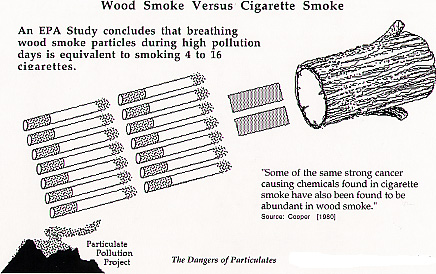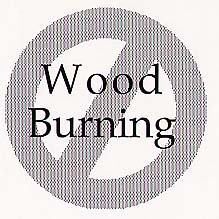Make an affirmation for your health by educating your family, friends and neighbors.
Fight denial in yourself and others. Talk about it! Silence is denial. Be courageous and support the right of everyone to clean air in their own home. Neighborhood smoke peaks at midnight, (70% of it seeps into every home) fight pajama'd passivity, put "work to reduce wood burning"on your daily list of activities. Nonburners are the majority. There are powerful lobbyists who are paid to work every day to suppress science about the health effects of wood burning and the right to clean air. Burning abuses will end when we admit that the friendly fire is not our friend.
Burning Issues Wood Smoke
Fact Sheet: as (14KB PDF)![]()
Burning Issues Wood Smoke Fast Facts
Burning Issues Brochures
2008 Outdoor Wood Boiler
Brochure![]() This brochure contains OWB facts and figures.
This brochure contains OWB facts and figures.
2007 Brochure![]() This is a general wood smoke
brochure. It explains the wood smoke problem and other air toxins and
talks about what you can do about it.
This is a general wood smoke
brochure. It explains the wood smoke problem and other air toxins and
talks about what you can do about it.
Cancer Brochure![]() This brochure describes the ways
that wood smoke is particularly dangerous for cancer patients and steps
that can lessen their exposure.
This brochure describes the ways
that wood smoke is particularly dangerous for cancer patients and steps
that can lessen their exposure.
2003
Brochure ![]() WOOD SMOKE Brochure Black & White
Pass out this brochure at wood burning restaurants, in your schools, at
work, at shops and in your neighborhood. Make sure the fire department
has copies. Bibliographic References
for 2003
WOOD SMOKE Brochure Black & White
Pass out this brochure at wood burning restaurants, in your schools, at
work, at shops and in your neighborhood. Make sure the fire department
has copies. Bibliographic References
for 2003![]() WOOD SMOKE Brochure (116KB
PDF)
WOOD SMOKE Brochure (116KB
PDF)
Printing Brochures: Open PDF with Adobe Reader. Select Menu Item: File->Print. In the PRINT dialog set Page Scaling to None. This will correct margins for tri-folding.
One page handout. Bay Area Wood Smoke
Plumes and Particle PAH by Wayne Ott.![]()
Dioxin-Ott-xmas-flyer ![]() of Wood Smoke Plumes and Particle PAH. It is the same study as below
with Dioxin Flyer
of Wood Smoke Plumes and Particle PAH. It is the same study as below
with Dioxin Flyer ![]() on the reverse.(2Page Handout):
on the reverse.(2Page Handout):
May 17, 2003:Burning Issues Hand out: print double-sided: Chemicals in Wood Smoke and Tobacco(112KB PDF)

Burning Issues: Wood Smoke
Hand Out with Wood Smoke Chemicals on one side and 'For Our
Children' on the other for Printing, 2 per page, double sided. (Jan. 16,
2003 update) ![]() (140KB
PDF)
(140KB
PDF)
The Particulate Pollution Project Education 1993 (This is a photo copy of the original. It is as relevant today as it was when it was created.) Page 2
Small Poster to put up on message boards. "Wood Smoke - it takes your breath away."
Two Short Articles for Newsletters.
Burning Issues Slide Show (1992)
Protecting Your Family from Neighborhood Wood Smoke
Self Protection from Pollution Checklist
gn="center">
1993 Government Document :WOODSMOKE AND YOUR HEALTH
# 91-br-023, 4 pages that you can download with acrobat. Written by Washington State Department of Ecology and endorsed by medical doctors . (Although Burning Issues does not endorse the sale of wood stoves, there is good health information in this brochure.)
American Lung Association Position on Wood Burning. (as a PDF file).
WHY IS WOODBURNING AN AIR POLLUTION PROBLEM?
In most areas of the country, woodburning from fireplaces and woodstoves
is the largest source of particulate matter air pollution (PM) generated
by residential sources. In some localities, fireplaces and woodstoves
have been identified as the source of 80% or more of all ambient
particles smaller than 2.5 microns in diameter (PM2.5) during the winter
months. A large body of evidence links PM with adverse health outcomes,
including excess mortality, especially among those with preexisting
cardiopulmonary illness.
Fireplaces and woodstoves, and even special equipment such as wood
pellet combustors and EPA Phase II Certified woodstoves, produce orders
of magnitude more particulate matter than well-tuned oil or gas devices
producing equivalent heat. Moreover, woodstoves routinely produce
several times more air pollutants than original design values simply
because of improper operation (including their misuse as incinerators
for residential refuse), maintenance, and normal equipment degradation
with use.
In addition to particulate matter, woodsmoke emissions contain
components such as carbon monoxide; various irritant gases such as
nitrogen dioxide, sulfur dioxide, hydrochloric acid, and formaldehyde;
and chemicals known or suspected to be carcinogens, such as polycyclic
aromatic hydrocarbons (PAHs), and dioxin.
Monitoring of airborne particulate matter and PAH levels in many
residential areas across the country shows that exposure to these
pollutants is consistent with the use pattern of residential wood
combustion. The sites studied are far from industrial sources and the
times of maximum pollutant levels do not correlate with local traffic
activity. Outdoor PAH levels in such residential areas have reached 2
micrograms per cubic meter during holiday evenings - comparable to the
maximum recorded PAH concentrations in secondhand tobacco smoke.
Studies have also shown that people using woodburning devices to heat
their homes can be routinely exposed to excessive levels of fine
particulate matter in their indoor air.
WHAT ARE THE HEALTH EFFECTS?
Findings from animal studies demonstrate a reduction in disease
resistance associated with woodsmoke exposure. Woodsmoke exposure can
disrupt cellular membranes, depress immune system activity, damage the
layer of cells that protect and cleanse the airways, and disrupt enzyme
levels.
The health effects of woodsmoke exposure include increased respiratory
symptoms, increased hospital admissions for lower respiratory
infections, exacerbation of asthma, and decreased breathing ability.
Population studies have shown that young children, the elderly, and
people with preexisting cardiopulmonary disease are most likely to be
affected.
As a major contributor to particulate matter air pollution, woodsmoke
can also be linked directly with a variety of other particulate
matter-associated health effects, including increased risks of school
absenteeism, emergency room visits and hospitalizations for
cardiopulmonary conditions and premature death.
WHAT ARE THE SOLUTIONS?
The American Lung Association recommends that individuals avoid burning
wood in homes where less polluting heating alternatives are available.
The use of the least-polluting alternative heating methods and cleaner
technologies should be promoted to provide useful heat, while minimizing
any adverse health effects.
For consumers who are considering replacing their wood-burning
appliances with gas-burning appliances, ALA recommends choosing vented
appliances whenever possible, to minimize potential indoor air quality
problems.
Thanks to the Washington State Lung Association for help and support on a proposed wood smoke restrictions bill at the State Legislature in Spring 2003. The bill did not succeed but the support from the WSLA was very much appreciated.
ALA Pages on Prevalence of Lung Disease and Other Facts This is excellent.
Caution: There is still a lack of public education material about wood smoke, candles and incense burning on the ALA site.
Be healthy - Stop burning things.
Personal Change in order to change
the world we too must change.
